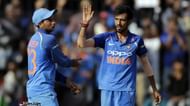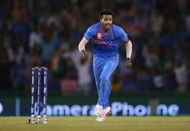
Change is needed they say but is change really welcome? Accustomed to the happenings of the world around, very few beings would want to get out of their comfort zones to once again modify and adjust themselves to the new. A new place, a new city or a new environment, each brings with it its own set of fears and challenges.
That is why when Virat Kohli took over the reins of the Indian cricket team from MS Dhoni, who had led them rather successfully for well over nine years, the hushed murmurs going around the cricketing circuits could not be ignored.
Would the maverick batsman be as good as Dhoni, who had a win percentage of almost 55? Or would his fiery aggression come in the way of leading the side? All those doubts were quickly quelled as the Delhiite set together a strong unit that walloped one opponent after another. Under his rule, India have played 34 ODI games since last year, winning 25 of them! Just when doubts began to creep in regarding his team’s performances in overseas conditions, Kohli bravely led India to their first ever bilateral series triumph in South Africa.
What made the win even more special is that except Australia, no other team had been able to defeat South Africa at home in a series with 5 or more matches, and not only did India win a series in Africa for the first time, they did so with full conviction and dominance.
These wins, which augur well for the side ahead of the next edition of the World Cup, are not just a flash in the pan but have been brought about after meticulous planning and introspection – a process that had started during Dhoni’s reign itself. But while the former could not end up enjoying the results of his efforts immediately, he did ensure that his successor would be equipped with a complete team. With Dhoni’s immaculate understanding and Kohli’s strong standards and bold decisions, the Indian team today stand as world-beaters.
The new spin-twins on the block

Upon first glance, one would always be tempted to credit the success of India’s new wrist spinners Kuldeep Yadav and Yuzvendra Chahal to the new captain. It does take immense courage to isolate two match-winners, Ravichandran Ashwin and Ravindra Jadeja, from the limited-overs format, especially since they were such a dominant duo in Dhoni’s team.
Coupled with their Test records, it would have been tempting to keep both players in the side despite their below-par overseas numbers, but Kohli failed to be lured by reputation and introduced the two wrist spinners in the team, which again was criticised as leggies are often prone to conceding runs even if they do pick up wickets.
With teams preferring to save runs in the middle overs, the tactic to employ wrist spin from both ends was considered suicidal at best. But with even Ashwin and Jadeja being smashed around the park in the Champions Trophy without many wickets to show for, Kohli immediately turned towards his trusted IPL bowler Chahal, and Kuldeep, who had already performed considerably well in the limited opportunities he had received in international cricket. The biggest reason for their success has been the unwavering confidence that the skipper has in them, which does not falter even when the two are being smashed around the park.
With wrist-spinners using their ring finger and palm for assistance, their dependence on the pitches vastly decreases, which explains why the finger-spinners that India had before could not replicate their sub-continental performances overseas. With Kuldeep picking up 38 wickets in 19 games at an average of 19.21 and Chahal picking up 26 in 14 at 15.92, India and Kohli’s tactical move has paid rich dividends.
Cricketing skills at par with fitness levels
A look back at the Indian cricket teams over the years will give a faint idea of how integral (or not!) fitness was to the players. The teams usually focussed on the cricketing skills possessed by certain individuals, with fielding and fitness levels hardly at par with international standards. One would not call Sachin Tendulkar or Virender Sehwag the “fittest” players in the history of the game, but with their exceptional batting potential, that could easily be overlooked.
That is why, maybe, when Dhoni kept aside Sehwag and the likes of Sourav Ganguly, VVS Laxman and Rahul Dravid from the CB Series Down Under in 2008, citing fitness issues, ripples were sent across the Indian circuit. In a long, long time a captain was focussing on this aspect of the game and needless to say, Dhoni was vehemently attacked.
Kohli has not only taken this aspect of cricket even further but has also set in place a stern Yo-Yo test, which each player has to pass to secure a place in the team. Under Anil Kumble’s stint as head coach, any injured player had to necessarily go back to the domestic circuit, prove his fitness and only then return to the international fold, but ever since Ravi Shastri has come on board, clearing the Yo-Yo test is all that is needed.
The test employs three cones - A, B and C - placed at a distance from each other. The first two cones are placed five metres away from each other and C is 20 metres away from B. The cricketer has to sprint from B to C and then from C to B at full pace. He then has to walk back to A and walk back to B for the next sprint. With each sprint, the number of seconds reduces and by the end, he has to run 40 metres in just eight seconds, which is at almost 18 kmph!
Kohli, who is a fitness freak himself, has a score of 21 in the test and even players like Manish Pandey, KL Rahul and Chahal have not fared that badly.
Not only do increased fitness levels help in taking quick singles and converting the ones into twos, it also helps in pulling off stunning catches, even if the ball is at a distance from the fielder. More importantly, the Yo-Yo test also tests mental strength and endurance levels, which Kohli is a master at.
Hence, the likes of Suresh Raina and Yuvraj Singh, who could not pass the test, were kept away from the national team, even though many believed that their presence could have solved India’s number four woes. With Kohli emphasising the need for his RCB teammates to pass this test as well, he is laying the foundation for younger players to focus equally on fitness as their batting or fielding.
The presence of a seam-bowling all-rounder

India’s quest for a seaming all-rounder was as famed as Trevor Chappell’s underarm bowling in 1981. Ever since the retirement of Kapil Dev and the exit of Irfan Pathan due to Greg Chappell’s bizarre tactics, the Indian team have never really found a player who could bat at number six in ODIs and don the role of the fifth bowler with ease.
Under Dhoni’s tenure, Abhishek Nayar, Stuart Binny, Dhawal Kulkarni, Rishi Dhawan and Jayant Yadav were all tried out, but with no success. Binny in particular was given an extended rope by Dhoni, after his 6-wicket haul in Bangladesh, but in the subsequent tour to England he was unable to replicate those performances. Then, there emerged Hardik Pandya, who impressed Kohli in particular with his nonchalance and his confidence in the IPL last season, while playing for Mumbai Indians.
Not only did Pandya pick up regular wickets for his franchise, he also batted lower down the order in the slog overs and provided a few hefty blows. He had already made his ODI debut, in November 2016, but it was under Kohli that he really emerged as a rising star.
In 36 ODI games, he has scored at an average of 31.4 and has picked up 36 wickets at an economy of 38.58. Even though these numbers are not jaw-dropping, Kohli’s belief in the player is unbelievable. In the final of the Champions Trophy, when India had been reduced to dust against Pakistan, it was Pandya who entered the scene and gave the team some hope, before a terrible mix-up with Jadeja led to his dismissal.
Even in the first Test against South Africa, when the Indian players were hell-bent on defending - a move that did not pay off - Pandya showed the way with a counter-attacking display with the bat. He is also a tremendous fielder and rarely drops catches, and it will be interesting to see whether Kohli’s backing can transform him into the all-rounder India have always been on the lookout for.
A controlled death bowling unit
One image that stands out from Dhoni’s captaincy is the horde of pace bowlers going for plenty by the time the slog overs arrived. Even though the likes of Bhuvneshwar Kumar impressed one and all with his swing and seam in the first few overs, he was a wreck in the last ten, going for runs all over the park. Only Mohammed Shami emerged as a reliable death bowler, who would pick up wickets at intervals, but it would all be undone with Bhuvi leaking runs all around.
Under Dhoni, on 13 occasions did his bowlers concede more than 80 runs in their 10 overs, with Bhuvi being the most expensive bowler. While doing so, they picked up only ten wickets, a sorry state of affairs indeed. Not only have these numbers dropped after Kohli’s ascendance, but Bhuvneshwar's emergence as a reliable slog bowler has ensured that Shami has been on the periphery. Of course, Jasprit Bumrah continues to be a revelation with his unconventional action and his yorkers, and the fear that once compounded the Indian cricket fans over the runaway runs in the last few overs has seemingly disappeared.
A fiery mindset and the ability to lead from the front
Though Kohli’s volatile fieriness comes across more in Test cricket, where Dhoni often paled in comparison, it cannot entirely be overlooked. While the former skipper was a defensive shadow in whites, Kohli, who might not exactly be known for his brilliant moves as a Test captain, sure does know how to rev a team up. Starting from his very first game as a leader in Adelaide, where he pushed his team to go for a target of 364, we saw glimpses of a skipper who would not wait for things to happen on a cricket field.
Along with that, his additional responsibility as a batsman who loves to lead from the front cannot be overlooked. In the 37 games that he has captained in ODIs, he has scored 2372 runs at an average of 98.83 in wins with 11 hundreds! Overall, he has played 48 games as a leader and has scored at 80.55, with 12 centuries. Since 2017, when he took on the role officially, he has an average of 105.13 in wins, and 85.86 overall!
Aware that most of the responsibility lies on his shoulders, with a jittery middle order to follow, Kohli has paved the way with his feats. He not only took over Dhoni’s already successful side but has been able to enhance it further to make it into a world beater.
Follow IPL Auction 2025 Live Updates, News & Biddings at Sportskeeda. Get the fastest updates on Mega-Auction and cricket news
